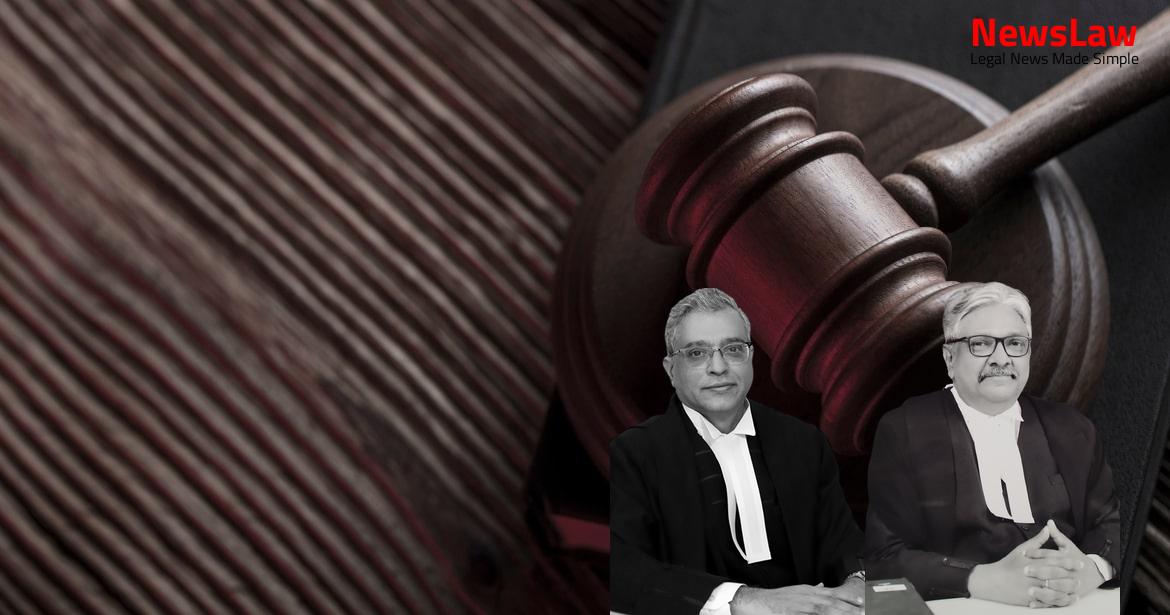In a significant legal battle, the Supreme Court of India has ruled on a dispute regarding termination and back wages. The case involved a prolonged absence and subsequent termination of an employee, leading to a complex legal battle between the parties. The judgment addresses key issues surrounding the termination and entitlement to back wages, setting a precedent for future similar disputes. Stay tuned for more insights on this landmark case!
Facts
- Appellant, who was a temporary employee, was absent for a total of 1968 days from 1987 to 1993.
- Medical Board found that the leave granted based on medical certificates was disproportionate to the severity of the ailments.
- Notice was issued for termination under Regulation 24 in 1994 due to continued absence.
- Appellant’s services were terminated by respondent-Corporation in 1994.
- Appellant’s reply was found unsatisfactory by the Corporation.
- Appellant filed a petition which resulted in reinstatement by the Labour Court in 2009.
- Appellant started as a temporary Assistant Grade-III and was later promoted to temporary Assistant Grade-II in 1990.
- The Labour Court held the termination of the appellant by the respondent-Corporation as illegal and void on 07.08.2018.
- Special Appeal No. 55 of 2004 was filed before the Division Bench of the High Court, which was dismissed on 29.06.2006 citing the appellant as a Workman and the case being an Industrial dispute.
- The appellant made a reference of the dispute to the Labour Court on 22.10.2008.
- The High Court partly allowed the Writ Petition No.3015 of 2017 filed by the respondent-Corporation, holding termination as illegal but granting back wages of 30% with other benefits as per the Labour Court’s Award.
- Writ Petition No.6742 of 2001 challenging the termination order dated 01.07.1994 was filed by the appellant before the High Court and later transferred to the Uttarakhand High Court.
- In the judgment dated 26.08.2004, the High Court dismissed the writ petition and upheld the validity of the termination order.
Arguments
- Appellant was initially appointed as a temporary Assistant Grade-III and later promoted to temporary Assistant Grade-II.
- Appellant’s excessive leave was found by a Medical Board to be based on medical certificates.
- Appellant was terminated in 1993 after a show cause notice and unsatisfactory reply.
- Tribunal set aside the termination order and granted full back wages and consequential benefits.
- Appellant’s absence from 1987 to 1993 was later ex-post facto sanctioned as leave by the Corporation.
- Regulation 24 of the 1975 Regulation regarding temporary employees was contested by the Senior Counsel for the Corporation.
- Appellant claimed to have worked for more than eleven years and was promoted in 1990, challenging the temporary employment status.
- High Court ordered 30% back wages instead of the full 100%, which was disputed by the Corporation’s Counsel.
- The High Court was correct in ruling that the termination of the appellant, considering her as a temporary employee under Regulation 24 of the 1975 Regulations, was unjustified due to her long period of employment exceeding eleven years.
- The appellant’s extended absence between 1987 and 1993 does not warrant reinstatement as the Corporation cannot be expected to provide work to an absent employee.
- If the termination is deemed unsustainable, the appellant may be entitled to a lump sum amount as back wages and compensation instead of reinstatement.
Also Read: CRPF Act: Validity of Rule 27 for Compulsory Retirement – Case of Head Constable vs. CRPF
Analysis
- Appellant remained absent for nearly 5.4 years out of a seven-year period, averaging to over 281 days per year.
- Appellant was initially deemed temporary but later considered permanent, despite prolonged absences.
- Appellant delayed approaching the Labour Court for over fourteen years after her termination in 1994.
- The termination order was challenged in 2008 at the Labour Court, leading to a delay in seeking resolution.
- Appellant’s frequent absenteeism was confirmed by a Medical Board’s findings, indicating a habitual pattern.
- High Court’s ruling that termination without a formal domestic inquiry is erroneous due to serious civil consequences.
- Regularization of absences by the Management as leave converted the period and disallowed it as a basis for termination.
- High Court rightfully declared that 30% back wages, not full, plus consequential benefits are suitable reparation.
- Choosing the incorrect forum for redressal caused further delay in seeking justice by the appellant.
- In this case, the appellant had a history of extended leave prior to termination, averaging 281 days a year for seven years.
- The respondent-Corporation is not obligated to assign work to the appellant due to her conduct.
- The appellant will receive salary until her superannuation in May 2020 but will not be required to work.
- Although the appellant’s absences were later converted to leave, she was deemed a habitual absentee, impacting her entitlement to back wages.
- The court ruled to uphold the setting aside of the termination but granted the appellant 10% back wages, reinstatement, and other associated benefits as a balance of justice.
Also Read: DAMEPL vs. DMRC: Curative Petition and Arbitral Award Restoration
Decision
- The High Court’s judgement dated 14.06.2018 has been modified with certain changes.
- Both appeals have been disposed of with the modifications.
- No costs have been ordered for either party.
Case Title: ANJANA MITTAL Vs. OIL AND NATURAL GAS CORPORATION LIMITED THROUGH MANAGER
Case Number: C.A. No.-005937-005937 / 2019



